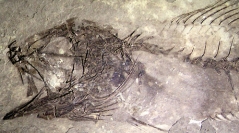

 Comptes Rendus Palevol
14 (8) - Pages 625-635
Comptes Rendus Palevol
14 (8) - Pages 625-635The family Moridae (Gadiformes) is diagnosed by an otophysic connection, a horizontal gas bladder septum, unique otoliths and a specific architecture of the caudal skeleton. Their skeletal fossil record is rather scarce and uncertain: the oldest proven representatives (from Oligocene sites of the Paratethys area) are classified in the genus Eophycis. Newly collected specimens from the Hermanowa locality (Poland) allow the description of and commentary on previously unknown characters. The species Eophycis jamnensis was a typical morid fish with an elongated body, a triangular head, and single dorsal and anal fins that are not coalesced with the caudal fin. This species was most similar to the Recent species Guttigadus nana that differs from it (as from other Eophycis species) in meristic features, having two dorsal fins but lacking a vomer. A brief review of the fossil skeletal record of morid fish is presented.
Gadiformes, Moridae, Bony fish, Anatomy, Osteology, Oligocene, Paratethys